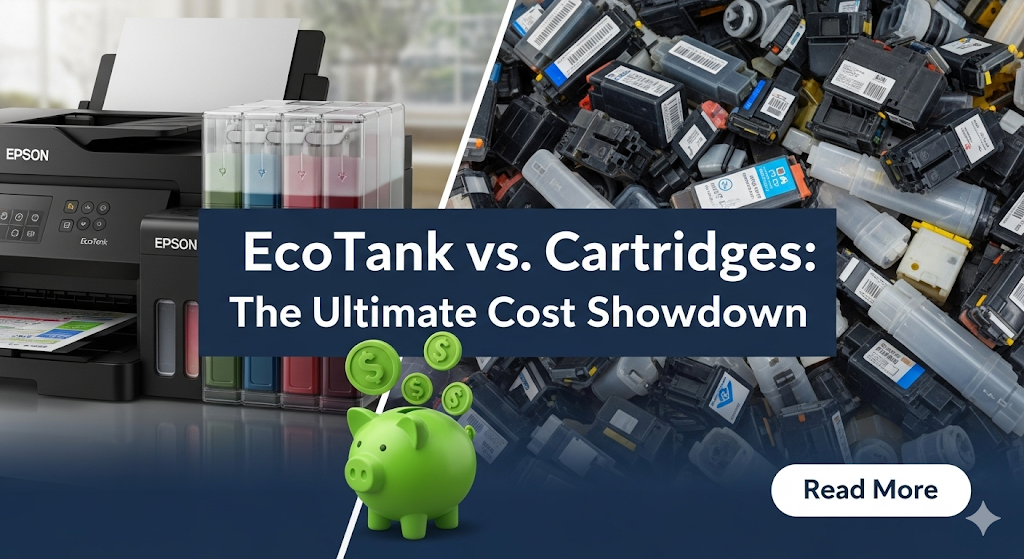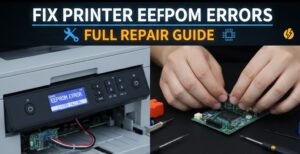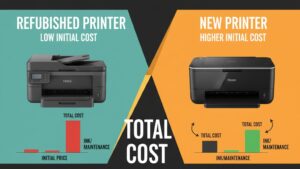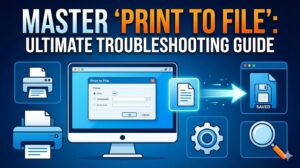Introduction
Understanding EcoTank vs traditional cartridges cost differences is crucial for making smart printing investments that save money long-term. Many consumers focus on upfront printer prices without considering the dramatic impact of ongoing ink expenses on their budgets.
Traditional cartridge printers often seem affordable initially but can cost hundreds or thousands more over their lifespan due to expensive replacement cartridges. EcoTank systems promise significant savings through refillable ink tanks, but the higher upfront cost raises questions about real value.
This comprehensive analysis reveals the true costs of both printing systems, including detailed calculations, real-world usage scenarios, and money-saving strategies. You’ll discover which option delivers better value for your specific printing needs and budget.
What Are EcoTank and Traditional Cartridge Systems?
EcoTank printers use large, refillable ink tanks instead of replaceable cartridges, dramatically reducing per-page printing costs. Users refill tanks with affordable ink bottles that yield thousands of pages, eliminating frequent cartridge purchases.
Traditional cartridge systems use sealed ink or toner cartridges that users replace when empty. These cartridges typically yield 200-500 pages and cost $20-80 each, creating ongoing expenses that accumulate quickly with regular use.
The key difference lies in ink storage and delivery methods. EcoTank systems store large ink volumes in external tanks connected to the print head through tubes. Traditional systems integrate ink storage directly into replaceable cartridges.
EcoTank vs traditional cartridges cost analysis shows dramatic differences in long-term expenses. While EcoTank printers cost $200-400 more upfront, ink refill bottles cost only $10-15 and yield 6,000+ pages compared to expensive cartridges.
This technology shift represents a fundamental change in printer economics, moving costs from ongoing consumables to upfront equipment investment.
6 Essential Methods to Compare EcoTank vs Traditional Cartridge Costs
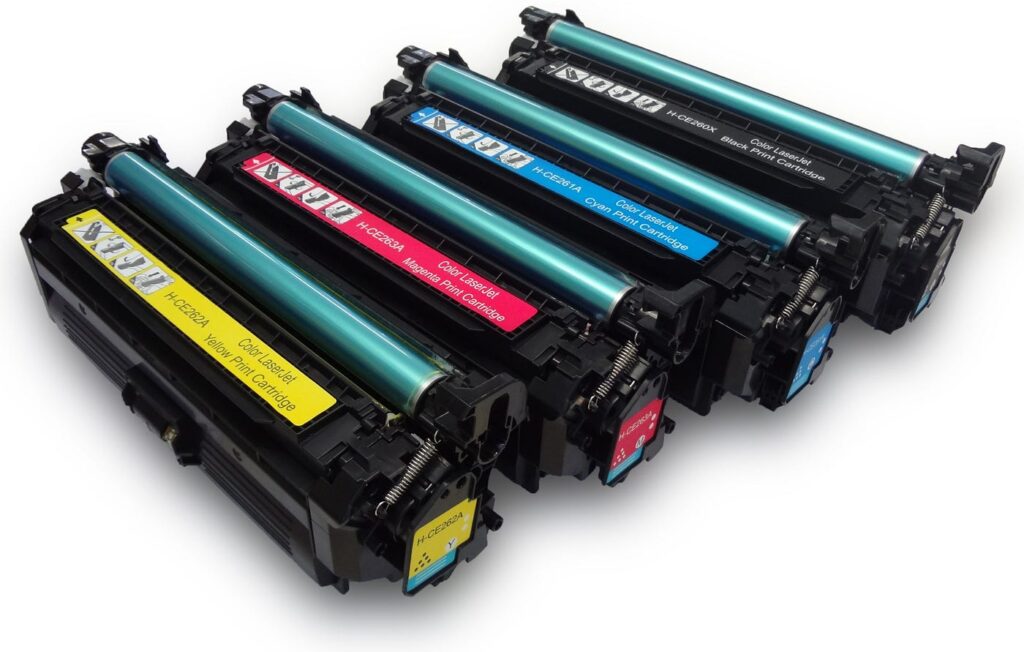
1. Calculate Total Cost of Ownership Over 3 Years
Start by adding printer purchase price plus estimated ink costs for your typical monthly printing volume over 36 months. This reveals true system costs beyond initial sticker prices.
For traditional cartridges, multiply monthly page count by cost-per-page (typically 15-25 cents for color, 5-8 cents for black). Add cartridge replacement costs based on yield specifications.
EcoTank systems front-load costs in the printer price but offer dramatically lower ongoing expenses. Calculate ink refill costs at approximately 1-2 cents per page for color and 0.3-0.7 cents for black.
Include paper costs, which remain constant between systems, but factor in any differences in print quality that might require premium paper for optimal results.
2. Determine Your Break-Even Point
Calculate exactly when EcoTank’s lower per-page costs offset the higher initial purchase price compared to traditional cartridge printers. This break-even analysis guides purchasing decisions.
For typical users printing 200-500 pages monthly, break-even occurs between 12-24 months. Higher volume users reach break-even faster due to greater consumable savings.
Create a spreadsheet tracking cumulative costs month by month to visualize when EcoTank becomes more economical. This analysis helps justify the higher upfront investment.
Consider your printer replacement cycle when calculating break-even. If you typically replace printers every 2-3 years, ensure break-even occurs well before replacement time.
3. Analyze Usage Patterns and Volume Requirements
High-volume users benefit most from EcoTank vs traditional cartridges cost advantages. Calculate savings based on your actual monthly printing patterns rather than estimated usage.
Light users (under 100 pages monthly) may never reach break-even due to low consumable costs. Traditional cartridge systems might provide better value for minimal printing needs.
Seasonal or irregular printing patterns affect cost calculations. EcoTank ink doesn’t expire quickly like cartridges, making it ideal for variable usage patterns.
Factor in color vs black-and-white printing ratios, as color printing shows the most dramatic cost differences between systems.

4. Compare Quality and Performance Factors
Evaluate print quality differences that might affect paper choices or reprinting needs. Both systems can produce excellent results, but some applications favor one technology over another.
EcoTank systems typically excel at photo printing with superior color accuracy and gradation. Traditional cartridges often provide sharper text for business documents.
Consider print speed differences, especially for high-volume users where productivity impacts overall costs. Some EcoTank models print slower than comparable cartridge printers.
Factor in reliability and maintenance requirements that create hidden costs through downtime or professional service needs.
5. Research Ink Availability and Pricing
Investigate long-term ink availability for both systems. EcoTank refill bottles must remain available and affordable to maintain cost advantages over time.
Compare ink pricing from multiple sources including original manufacturer, third-party suppliers, and bulk purchasing options. Price stability affects long-term cost projections.
Evaluate ink shelf life and storage requirements. EcoTank bottles typically last longer than cartridges, reducing waste from expired supplies.
Consider geographic availability of supplies, especially for businesses with multiple locations that need consistent supply chains.
6. Factor in Environmental and Convenience Costs
Calculate disposal costs and environmental impact of frequent cartridge replacements versus occasional bottle purchases. Some businesses factor environmental responsibility into purchasing decisions.
EcoTank vs traditional cartridges cost analysis should include convenience factors like shopping time, storage space, and administrative overhead for supply management.
Consider subscription services that automatically deliver cartridges versus manual ink bottle purchases. Convenience features may justify price differences for busy users.
Evaluate warranty coverage and support quality that affect total ownership experience and potential replacement costs.

Advanced Cost Analysis Tools and Calculators
Online cost calculators help compare specific printer models with your actual usage patterns. These tools factor in local ink prices, usage volume, and replacement schedules for accurate projections.
Spreadsheet templates allow detailed tracking of actual costs versus projections over time. Monitor real-world performance to validate initial cost analysis and identify optimization opportunities.
Print management software provides usage analytics that improve cost calculations and identify waste reduction opportunities. These insights help optimize printing habits regardless of technology choice.
Vendor cost analysis tools often provide biased results favoring their products. Use multiple independent sources to verify calculations and identify potential hidden costs or inflated savings claims.
Common Cost Analysis Mistakes That Waste Money
Underestimating actual printing volume leads to incorrect cost projections and poor technology choices. Track real usage for at least one month before making purchasing decisions.
Ignoring print quality requirements can result in reprinting costs or premium paper expenses that offset savings. Match printer capabilities to actual output needs.
Focusing solely on ink costs while overlooking printer reliability creates false economy. Frequent repairs or early replacement eliminate consumable savings.
Not considering ink expiration dates wastes money on unused cartridges or bottles. Match purchasing patterns to actual consumption rates for optimal cost management.
Overlooking third-party ink compatibility eliminates significant cost savings opportunities. Research compatible options that maintain quality while reducing expenses.
Buying based on promotional pricing without considering long-term supply costs creates budget surprises. Evaluate regular pricing for sustainable cost projections.
Failing to negotiate volume discounts misses savings opportunities for high-volume users. Many suppliers offer significant discounts for bulk purchases or annual contracts.
Frequently Asked Questions
Q: How long does it take for EcoTank to pay for itself compared to traditional cartridges? A: Typically 12-24 months for average users printing 200-500 pages monthly, with break-even occurring faster for higher volume printing.
Q: Do EcoTank printers work as well as traditional cartridge printers? A: Yes, modern EcoTank printers match or exceed traditional printer quality while offering significantly lower operating costs for most applications.
Q: Can I use third-party ink in EcoTank systems? A: While possible, using non-original ink may void warranties and affect print quality. Original manufacturer ink ensures optimal performance and support.
Q: What happens if I don’t print often with an EcoTank system? A: EcoTank ink has longer shelf life than cartridges, but very light users may not reach cost break-even due to minimal consumable expenses.
Conclusion
The EcoTank vs traditional cartridges cost analysis clearly shows significant long-term savings for most users, with break-even typically occurring within 12-24 months of purchase. Higher volume users see even faster returns on their investment.
Traditional cartridge systems remain viable for very light users who print fewer than 100 pages monthly and prefer lower upfront costs. However, most home and small business users benefit from EcoTank’s superior economics.
The key to maximizing savings lies in accurate usage assessment, proper cost calculation, and choosing the right system for your specific needs. Don’t let higher upfront costs discourage you from significant long-term savings.
Make your decision based on total cost of ownership rather than purchase price alone. The most expensive option upfront often becomes the most economical choice over time.
Most Economical Office Printers 2025: Ultimate Cost-Per-Page Analysis Read More.

